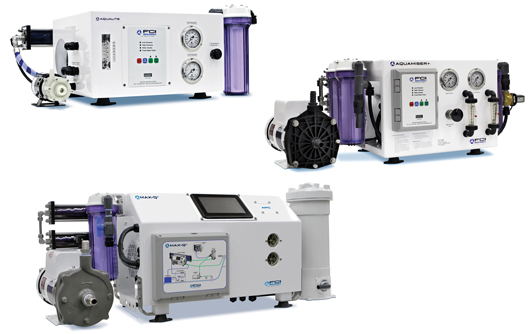
Why Invest in a Watermaker? and How to choose one?
Watermakers provide an almost endless supply of pure, fresh water and offer boat owners the flexibility to be out at sea almost indefinitely. This provides peace-of-mind knowing that tanks won't run dry 500 miles from the nearest source. Drinking, cooking, bathing, cleaning, laundry-even rinsing the deck-become worry-free. When investing in a watermaker, a little research, planning and product comparison ensures this equipment meets the owner's needs.
Apart from convenience, safety is an important consideration. If a vessel is stranded offshore, access to water becomes the single most important survival need. From a performance angle, less stored water means a lighter boat. This translates into lower fuel consumption and greater speed underway.
At first glance, watermakers may seem intimidating and technologically difficult to understand, especially when they're referred to as reverse osmosis desalinization units. But like a modern multifunction navigation system, using one is easy and quickly learned. Quality units will have simple, intuitive controls that regulate the watermaking process. Advanced models offer touch screen menus and full automation.

(from the top) FCI Watermakers - 22790 FCI Watermakers Aqualite, Aquamiser+ and Max-Q+
Selecting a model is a matter of estimating needs and deciding on a budget. Watermakers are rated in gallons per day (GPD). Smaller units will produce 200 GPD, while larger models can make more than 1,800 GPD. The US Coast Guard recommends that every person on board should have access to 30 gallons of water a day.
Watermakers actually don't consume much electricity. Smaller units have an 8 amp draw on 110/115V, or 4 amps on 220/230V. Larger models are around 2.29 kW on 120/220/380V. This can be produced by a generator, or a 12 volt DC solar- or wind-driven power system.
The owner should determine the number of hours the watermaker will need to operate to produce the desired gallonage. If the unit needs to run only briefly every day, a larger unit with a greater production potential may be the answer.
Once the desired GPD, power availability and production time are factored together, owners can look for a watermaker that fits their budget. Like most advanced equipment, the more options, the greater the cost.
Entry-level models, like FCI Watermakers' Aqualite and Aquamiser, will make 200 and 250 GPD, respectively. The Aquamiser can be upgraded later on to produce up to 1,800 GPD. Units such as this have a price point easily within reach of the average boat owner.
Larger, more advanced models, such as the company's Max-Q+APC, offer full automation and 750 GPD, expandable to 1,850. Units like this come with state-of-the-art controllers and touch screen displays.
Once final aspect to consider when choosing a watermaker is the availability of parts. Bargain units that rely on proprietary parts can easily cut a journey short if replacements aren't available. Companies such as FCI Watermakers use only non-proprietary parts, and a global network of authorized dealers and distributors to keep their products up and running.
FCI Watermakers, 3782 W 2340 S "E", West Valley, UT 84120. 801-906-8840 or toll-free in the US 800-850-0123. info@fciwatermakers.com, www.fciwatermakers.com.
TOP
|